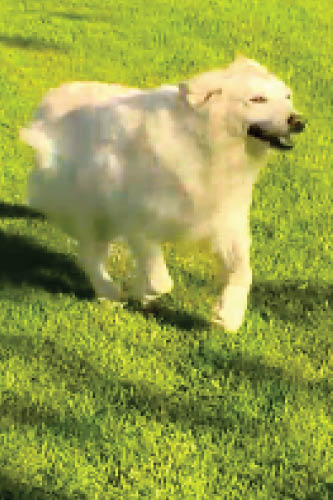Hello Cameron, what a year it has been! Can you tell us a little bit about what you're doing right now?
Hello Naomi! I'm back in the UK after a break in SA and spending some family time. It's rare that I have the time to do what I'm grateful for. During lockdown I've spent a lot of time deleting some releases that I never really had the time to prioritize at the clinic.
What's next?
I am in the process of building a new regenerative medicine and osteoarthritis service and also enjoy spending time with CPD and building connections within the profession.
Wow, every minute counts by the sounds of it! For those who are not yet familiar with your work, can you give us a brief summary of your veterinary career to date?
After qualifying and working as a GP and OOH vet for some time whilst being drawn into research the work turned out to last me for several years, the work was always focused on the clinical implementation of the core research within of stem cells, biomaterials and tissue engineering. I spent some time at the University of Edinburgh and then with the Bone and Joint Research Group at the University of Southampton. After that, I wanted to get back into practice and see if it was possible to truly translate the area of basic research into clinical application, and joined the Fitzpatrick Referrals team to help deliver biological therapies to support conventional orthopedic surgery and... for our loved ones to help patients with osteoarthritis.
You have been part of the highly successful regenerative medicine service at Fitzpatrick Referrals. While this was very rewarding, it must have been quite draining mentally as well, especially considering how intense and emotionally driven much of the work is. What drives you personally?
Yes, it was certainly a demanding role and I didn't have half the work of part of the team! Importantly, it has been tremendously rewarding that we have been handling variable and complex cases on a daily basis and fortunately have been able to provide the best possible care with the staff and physical facilities. Working in such an environment offers a clinician a canvas and a tool set that is so rarely available. He is part of the development of treatments and care for the animals in our care and by extension the families, which really helps keep you in and walking between the waves. So yes, full on but worthwhile.
Is there a case that particularly stands out for you?
Ah, there are those cases that just make you chuckle when you think about it! It certainly doesn't happen in every dog, but when you see this change it's so encouraging. I can imagine a lovely older black labrador who is part of a family of 2 dogs and 2 vets. They had seen their girl slow down over the year as would be expected for the breed and age, in the months prior to meeting her dog had continued to slow down and could only go to the bathroom and not much else. They were walking another dog I had worked with and were encouraged by what they saw so they came to visit. After evaluating other modalities, including surgical, medical, and rehabilitation options, we decided on an intra-articular autologous stem cell program with supportive care.
Within a month I was being sent videos of a rejuvenated black lab trotting in fields and along river paths, having previously been restricted to short walks and tiring quickly! The family told me it was like being years younger and very happy. That really meant a lot to me, a clear success with lots of smiles.
Such an incredible story. In your opinion, what have been the greatest advances in veterinary clinical research in recent years?
Do you mean OA research? That's a big question, and my little window on the world doesn't really do it justice. However, from a translational research perspective, I would suggest that expanding the cellular and molecular underpinnings of the disease process, as emerging from in vivo research, and how they lead to intelligent, targeted therapy development, will undoubtedly benefit human and human life animal will change .
We are becoming more aware of the “how” and “why” and with the co-development of treatments now discussed in the human and veterinary literature, the rate of treatment improvement has skyrocketed. We have moved from viewing OA as a hopeless disease “as best we can” to a well-known dynamic process with many opportunities for mitigation and, more importantly, outcomes leading to an improved quality of life.
How did you first hear about Antinol and what particularly aroused your interest in Antinol?
I was approached by Milly and Dave at VetzPetz who brought Antinol to my attention to see if we could use it in our OA cases. As everyone knows, it's not exactly uncommon for a new product to come your way, especially in the world of supplements. To their credit, the Antinol team was able to demonstrate a good base of supporting information regarding product safety and efficacy, leading to the decision to propose its use in a much more convenient advisory context. The world of supplements can be ambiguous, it was important to me to be able to safely refer colleagues and owners to the research.
Treating OA and chronic musculoskeletal disorders is a multifaceted treatment monster, which is why it is so important to consider all options and include as many complementary interventions as is reasonable and possible. Lipid supplementation is one of these areas and it is in this area that Antinol has been promoted as an advancement in the field of lipid supplementation. Nothing new per se, but I respected the peer-reviewed data submitted in support of Antinol, which was probably the "foot in the door" for wider use.
How did you integrate it into your work?
As an addition to the management strategy for OA/mobility cases. This can be done as a standalone supplement or in combination with other combination supplement products. Anecdotally, it was not uncommon for a family to report noticing a benefit in using Antinol in combination with other supplements compared to either product alone.
Cases where the use of NSAIDs is contraindicated and where anti-inflammatory properties are sought. There is data that suggests an analgesic aspect when administered as a sole agent and it may be possible to obtain further effects when used with the newer "non-traditional" NSAIDs that are on the market or come on the market. In cases where stem cells are administered, it has become an accepted protocol in both human and veterinary medicine to restrict the use of NSAIDs and steroids for a period before and after cell delivery. This is a much bigger conversation, however, this is still a time when the animal is experiencing pain and discomfort, and certainly a time when anti-inflammatory support is desirable.
Would you recommend using it?
In short, yes I would. It became an easy-to-integrate product as part of a strategic management plan for the OA patient. To be honest, it's not always a game changer, but the more I suggested it to the owners, the more often I got very positive feedback. In some cases, families wanted to try the supplement alone, and I received clear positive messages from those who received Antinol alone. With the increasing number of cases and feedback, my pleasure in recommending Antinol also increases.
Her personal research interests include phenotypic characterization of canine stem cell populations and optimization of the cell scaffold environment to enhance therapeutic effects. Chloe, our RVN, spoke about a stem cell case where you use Antinol. She was excited to understand the context and why this might be an appropriate use.
In order to maintain a healthy joint, the body is in a state of balance between renewal and breakdown. I think of a forest or meadow cleared by fire and then new living growth. In the arthritic joint, the embers of fire continue to burn and the new shoots struggle to grow. When stem cells are introduced into the joint, they generate a range of anti-inflammatory and "mitigating" signals that help restore the natural balance of tissue renewal. Omega oils like those in Antinol form part of the cell membranes of new cells and help produce the moderating signals. In addition, they are also involved in the formation of the cartilage matrix. If we think of cartilage as a carpet covering our joints, then lipids help form some of the fibers in this woven covering. I confess that I do not know the exact degree to which this effect is synergistic, but the contributing action of both elements has been extensively described in the literature. I was also interested in treating my cases with pain relief around the time of the injection as described in the question above
How do you handle most OA cases?
First, keep an open mind, an OA presentation is an opportunity to improve the patient's quality of life with just a little planning and care. All animals should be examined as if we were investigating the cause of lameness or effects on mobility. It is important not to make assumptions about the patient's condition or expectations; Medical history, all options, treat.
Confirm the cause, identify the underlying pathology and treat as most appropriate, sometimes this can be a simple change, sometimes we could devise a multi-faceted programme.
Always consider and discuss all options. The vet should lead this conversation as a healthcare professional and offer all the options as best they can. So often we have expertise in one area and can end up tending to cover in that area. There are many approaches and as a profession we should like to form a treatment network, not just a single strand.
Once we are certain that surgery is not indicated, options include intra-articular therapy, medical management of pain with supportive nutrition, physical therapy, exercise, and lifestyle modification. Changes take time, so it's important to track progress as best you can. Again, there are many tools that can help you. This is an important step as it helps engage families, improve compliance and certainly contributes to better outcomes.
Thank you for your time Cameron, we really appreciate it and look forward to hearing more about all of your upcoming projects.
If you are a veterinarian at an OA clinic and are looking for a source of information for your pet owners, Cameron has also kindly written a summary of expert OA advice for pet owners.

Do you have a story to tell or insights to share? Get in touch! You can email us.









